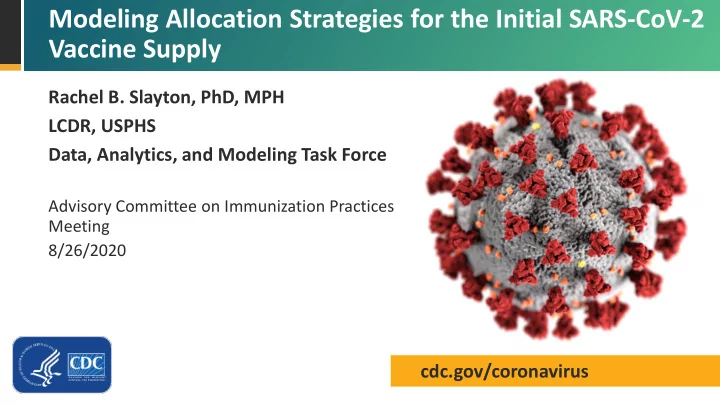

Modeling Allocation Strategies for the Initial SARS-CoV-2 Vaccine Supply Rachel B. Slayton, PhD, MPH LCDR, USPHS Data, Analytics, and Modeling Task Force Advisory Committee on Immunization Practices Meeting 8/26/2020 cdc.gov/coronavirus
Presentation Overview U.S. Population Stratification Model Nursing Home Model
Considerations for Mathematical Modeling Mathematical modeling is an iterative process Models should be updated as new data become available Sensitivity analyses enable systematic exploration of uncertainty
U.S. Population Stratification Model
U.S. Population Stratification Model Methods Stratification based on National Health Interview Survey (NHIS) 2016-2018 – Self-reported age, race/ethnicity, occupation, medical conditions – Sample size 85,187 adults, 28,221 children (0-17 years old) Age groups: – 0-17, 18- 64, ≥65 years Race/ethnicity: – Non-Hispanic White – Non-Hispanic Black – Hispanic – Other
U.S. Population Stratification Model Methods, Continued Risk Status (within each age group): – Either 0 or ≥1 high -risk medical conditions – NHIS-reported conditions: Obesity, chronic obstructive pulmonary disease (COPD), chronic cancer, weak/failing kidney, chronic heart problem, chronic diabetes Priority occupational groups: – Healthcare personnel (i.e., any individual working in a healthcare setting, paid or unpaid) – Essential workers: food supply, emergency services, utilities, critical financial services, government, education
U.S. Population Stratification Model Methods, Continued Modeled a scenario including partial reopening and social distancing – School contacts reduced by 70% from baseline – Workplace contacts reduced by 50% from baseline (except for healthcare and essential workers) Assumed vaccine efficacy by age group per 2-dose course – Analysis 1: 70% for persons 18- 64 years old, 50% for persons ≥65 years old – Analysis 2: 70% for persons 18- 64 years old, 70% for persons ≥65 years old Assumed immunity pre-vaccination – By age group: 0-17 years 2.8%, 18- 64 7.9%, ≥65 years 4.4% Mortality – Unadjusted risk ratios by age, race/ethnicity and risk factors, adjusted to model strata by raking
U.S. Population Stratification Model Methods, Continued Model considers incremental and relative impact of vaccination course – Contact rates among the 72 strata in the model based on age and location structured contact rates (i.e., home, school, work, other) Deterministic compartmental model framework Incremental impact estimated includes both direct and indirect benefits – Assessed the impact on population-wide incidence – Derived from estimates of the rates of most probable transmission among groups before and after vaccination
Relative Impact from the U.S. Population Stratification Model: Analysis 1 Population Population -wide decrease in rate per 10 million courses wide decrease in rate per 10 million courses Group vaccinated Group vaccinated COVID COVID -19 Infections 19 Infections COVID COVID -19 Deaths 19 Deaths Healthcare personnel 3.5% 3.3% Essential workers 3.1% 3.1% With underlying conditions 3.8% 4.3% Persons ≥65 years old 0.7% 6.1% Vaccine Efficacy (VE) assumptions 70% among persons 18-64 years old 50% among persons ≥65 years old
Relative Impact from the U.S. Population Stratification Model: Analysis 2 Population Population -wide decrease in rate per 10 million courses wide decrease in rate per 10 million courses Group vaccinated Group vaccinated COVID COVID -19 Infections 19 Infections COVID COVID -19 Deaths 19 Deaths Healthcare personnel 3.5% 3.4% Essential workers 3.2% 3.2% With underlying conditions 3.9% 4.8% Persons ≥65 years old 1.0% 8.6% Vaccine Efficacy (VE) assumptions 70% among persons 18-64 years old 70% among persons ≥65 years old
Nursing Home Model
Nursing Home (NH) Model Overview Parametrized to mean nursing home characteristics from an analysis of Centers for Medicare & Medicaid Services (CMS) data – 87 residents (mean length of stay 88 days) – 41 healthcare personnel (HCP) who work in daily 8-hour shifts HCP interact at work with other HCP, and at home and in non-school settings with others in the community HCP self-isolate on symptom onset Prevalence of infection among admitted nursing home residents is assumed to follow community prevalence First vaccine dose is given before introduction of infection into a nursing home
Product Assumptions 2 doses given 28 days apart Protection develops 14 days post-injection Vaccine Efficacy (VE) variable: 70%, 50%, 30% (among persons ≥65 years old) Assume that vaccination does not attenuate severity nor transmissibility of breakthrough infections Assume no waning of immunity over the analysis time horizon
SARS-CoV-2 Transmission Among Nursing Home Residents and Healthcare Staff Without Vaccination Simulation of unmitigated outbreak in a typical skilled nursing facility
Potential Impact of Focused Vaccination at Nursing Homes Vaccinating NH HCP results in greater reductions in both infections and deaths than vaccinating NH residents Residents assumed to be at higher risk of severe disease and death due to older age and presence of underlying conditions
Modeling Summary Vaccinating h ealthcare personnel, essential workers, or adults with underlying conditions resulted in reductions of COVID-19 infections and deaths Vaccinating adults ≥65 years old resulted in more modest declines in infections and larger declines in deaths Vaccinating nursing home healthcare personnel resulted in greater reductions in both infections and deaths than vaccinating nursing home residents
For more information, contact CDC 1-800-CDC-INFO (232-4636) TTY: 1-888-232-6348 www.cdc.gov The findings and conclusions in this report are those of the authors and do not necessarily represent the official position of the Centers for Disease Control and Prevention.
Recommend
More recommend